 Street furniture, post boxes, phone boxes, British
Relay boxes, Water Works etc.
Street furniture, post boxes, phone boxes, British
Relay boxes, Water Works etc. Our streets are littered with posts, boxes, signs and bollards to which someone once gave the rather flattering term: 'street furniture'. Bits and pieces of kit which are of varying usefulness and aesthetic merit plus baffling objects which are, frankly, unknown in their utility. Some of these embody lettering.
Street furniture can be found on some of the other pages on this website; for example, a full roster of surviving (as of 2014) tramway poles on the St Helens Street page, all removed in 2017.
Postal Boxes
207 Woodbridge Road
'V - R' (corner of Woodbridge Road and North Hill Road)
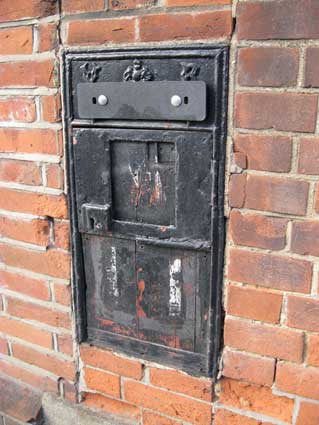
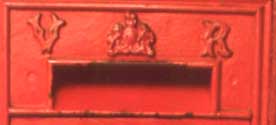 2013 images
2013 imagesLooking more like a postmodern art installation, this postal box was in use for as long as the 207 Woodbridge Road was in use as a post office. It was always a dangerous stop-off for the Royal Mail vans on the corner at the foot of Albion Hill, opposite the Duke of York public house; the drivers probably don't miss it. We think it closed down in around 2000, if not before. The 'VR' peeking over the plastic strip which blocks the letter slot stands for 'Victoria Regina' (meaning Queen Victoria in Latin) and indicates that the wall box was probably made at some date from 1885 onwards (see below).
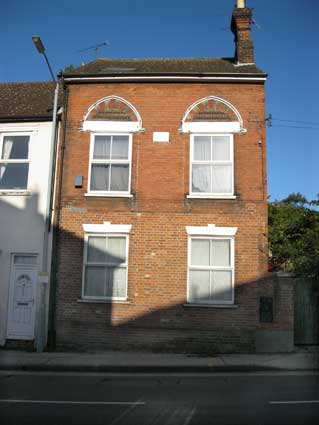
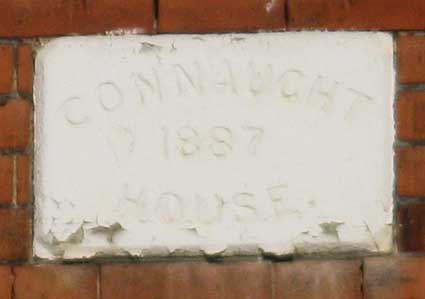 Connaught House 1887
Connaught House 1887 The history of postal boxes is a huge study all its own and a quick check on the internet will demonstrate the complexity and variety. Suffice to say that, rather than try to extract the box from the rather weak-looking brickwork, the Royal Mail must have decided to blacken the familar red colour, remove everything they could and block the slot. It is also clear from the vertical breaks in the wall that a longer box may once have occupied the site.
Julian Stray, of The British Postal Museum & Archive responded with the following information:
'The black painted box means that it has now been withdrawn from use. ... They are Ludlow boxes (and Cole and Carpenter), for that is what the box is. As you can see, it has also had an addition to the front face at a later date.' The image to the right shows what the lettering and royal crest would once have looked like when the box was 'live'.
James Ludlow and Son of Birmingham (1885-1965) were very prolific and hold a unique place in postbox history. For more than eighty years they were the main supplier of 'economy' wall boxes for use in sub-post offices. This came about because any person taking on the role of Postmaster at a sub-post office without a pre-existing box was required to provide one at their own expense! This led to some rather wonderful locally made boxes, known as Carpenter's Boxes, coming in to use. To authenticate them, they were frequently adorned with an official Post Box plate which resembles those used on the Ludlow boxes. This information comes from Steve Knight's fascinating website.
See our Orford, Alderton, Bawdsey page for the rare Edward VIII wall box.
St Peter's Street/Silent Street
We get the impression that this attractive Victorian pillar box appeared fairly recently on this corner. We recall first seeing it several years ago with one of them new-fangled 'modern'-type post boxes with rounded-off corners nearby. The latter has been removed. Any more information on this gratefully received.

The aperture of this beautiful piece of street furniture has been partially gagged by a nasty slotted dark grey plate with two bolts (see defunct example above). We can only assume that the Post Office didn't appreciate the objects being placed into it, or is it that since extra charges were imposed on larger/thicker mail, they wanted to ensure that only small letters and postcards are posted inside? Neither explanation is wholly satisfactory.
The central royal crest is flanked on opposing faces of the hexagonal box by:
'POST ... OFFICE'
with the centred 'VR' insignia beneath
with the centred 'VR' insignia beneath
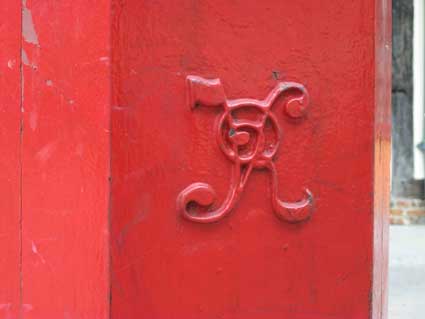
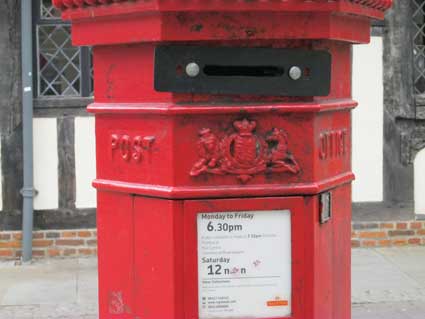
The Steve Knight website cited above tells us that this is apparently a 'Penfold', which is an exact replica of a Victorian hexagonal pillar box of 1866, named after the architect J. W . Penfold. This suggests that it was installed by the Post Office in this ancient part of town (close to what was to become the site of Cardinal Wolsey's statue in 2011, also to Curson Lodge which can be seen behind the first full-length image of this box) to add an 'historic' flavour.
Lloyds Avenue
A few yards outside the Lloyds arch stand two Royal Mail boxes. The first is a modern, plastic affair for franked mail. The second is of more interest as it is an oval double post box in cast iron painted in the traditional pillar box red and black: a modern Royal Mail branded EiiR Type C double aperture pillar box.

 2013 images
2013 imagesThe twin slots of the oval box used to be intended for first and second class mail, but it looks if this distinction isn't made here. At the rear of the box is the manufacturer's mark and date:
'MACHAN ENG
SCOTLAND
1993'
SCOTLAND
1993'
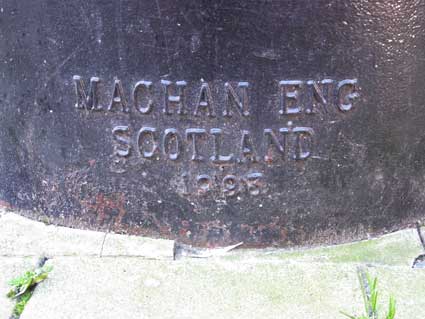
Machan Engineering is a young foundry in Denny, Stirlingshire: 'As well as street furniture, Machan also manufactures all the post boxes for the post office in the UK, supplies British Telecom with parts for the old red telephone boxes and refurbishes old red telephone boxes which are sent all over the world. So, next time you see a post box, red telephone box or item of street furniture, think Machan Engineering.'
Museum Street
This example is situated at the side of the Monsoon shop at 33 Westgate Street.
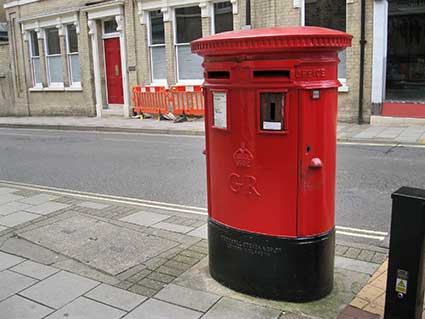
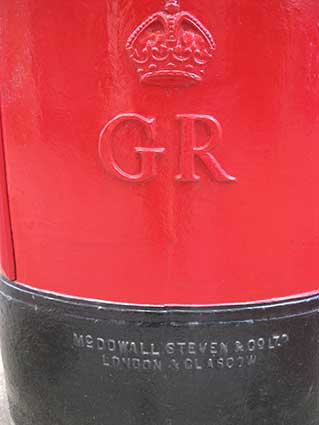
The manufacturer's name is in relief capitals around the front skirt of this double aperture pillar box:
'POST ... OFFICE
GR
MCDOWALL STEVEN & CO LTD
LONDON & GLASGOW'
GR
MCDOWALL STEVEN & CO LTD
LONDON & GLASGOW'
'GR' (George Rex) refers to King
George VI who ruled from 1936 to 1952 following the abdication of his
brother, Edward VIII

 -2016
images
-2016
imagesMcDowall Steven & Co. Ltd. had their roots amongst the founders of the cast iron industry in Scotland in 1804. Many pillar boxes bear the company stamp, most of these originating from the period when the company relocated to Falkirk, taking over Laurieston Ironworks around 1912. See also our Museum Street page.
Cliff Road
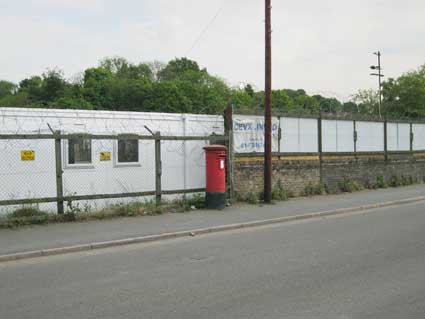 2014
images
2014
imagesThe song by 1960s West Coast psychedelic funsters The United States of America Stranded in time could have been written for this location. This substantial cast iron, Elizabeth II pillar box used to serve all the dockside businesses down this side of the Wet Dock and Cliff Quay (see our Wet Dock map for location). It stands opposite the Ship Launch public house (at the time of photographing, The Ship Launch Chinese Restaurant and Bar) and the mid-19th century cottages beside it which appear on the The Ipswich Society's (see Links) original Local List book. One can only wonder how many letters and postal packages are collected by the Post Office from this box.

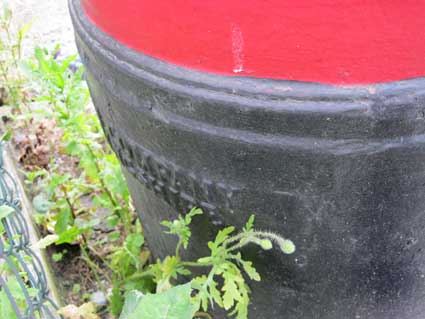
The casting at the back of the base bears the name of the manufacturer; it differs from the 'Machan' lettering shown on the Lloyds Avenue box, shown above. Almost impossible to photograph, after some research we can confirm that the cameo lettering reads:
'CARRON COMPANY
STIRLINGSHIRE'
Just across the road is the excellent '1919
RANSOMES' lettering on a brick warehouse.STIRLINGSHIRE'
Carron Company, an ironworks
established in 1759 on the banks of the River Carron near Falkirk, in
Stirlingshire, Scotland, was to become one of several foundries
producing
pillar boxes (and was one of five foundries casting Sir Giles Gilbert
Scott's classic red telephone boxes – see below).
Telephone kiosks
Henley Road. Once a very familiar feature of our towns, cities and villages, the K6 telephone kiosk designed by Giles Gilbert Scott in 1926 for The Post Office is becoming more common as a private garden feature than a utilitarian piece of street furniture. Here is an example of a telephone kiosk outside The Greyhound public house in Henley Road, which must date from before 2011, we think.
Before
 Photograph courtesy John Norman
Photograph courtesy John Norman After
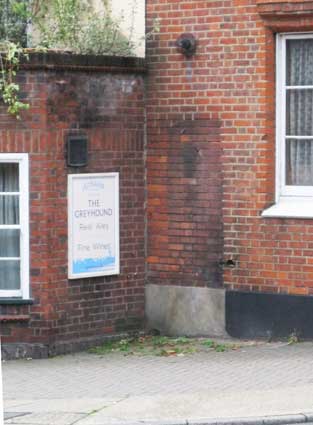
 2013 images
2013 imagesHere we are in 2013 with a few sad weeds and a darker, unpointed patch of brickwork on Newark Lodge (see Named buildings) marking the former location of the kiosk. As far as we are aware, there is only one K6 with a working public telephone in Ipswich and that is outside County Hall. An unsung survivor, albeit in 2014 with neither telephone nor door, is next to Stoke bridge. 1980s photographs of it appear on our Trinity House buoy page.
[UPDATE 20.5.2014: We have received a series of photographs of the removal of The Greyhound box, soon to be on its way to the great telephone exchange in the sky.]
[UPDATE 22.1.2023: 'I was at school in Henley Road from 1951 to '62, and I am sure that for a lot of that time a Dr Who-type blue police box stood in that corner by the Greyhound. Sadly, I do not have a photograph of it, nor of the famous bulbous Hospital Chimney which dominated our classrooms. Nick Wiggin']
Lincoln's Inn Fields. Central London seems to care more for its phone boxes better than most and this collection, presumably assembled deliberately rather than having evolved at this site, can be found in Carey Street, Lincoln's Inn Fields: two 1924 'K2' boxes flank a pair of 'K6' boxes with recent (and rather invasive) stone seating and cast iron bollards.
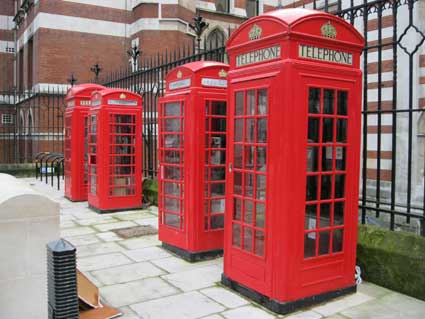
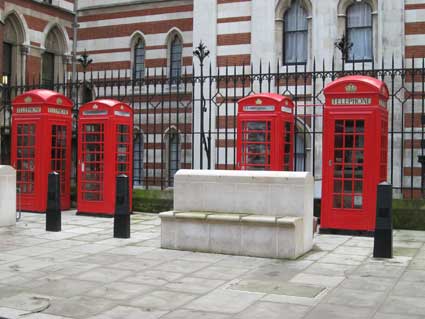
'Could it be Roman?
For well over thirty years, my wife and I have lived on Belstead estate, which as you probably know, was developed in the nineteen sixties. A couple of years ago, when I was sending you one or two photos for your Ipswich Lettering website, my wife mentioned that she had noticed what she thought was a small ancient headstone just down the road near Gusford School, Sheldrake Drive. It might be of interest to Borin, she suggested. Recalling the gold torques that were unearthed when this area was under construction, it seemed worth investigating.
Naturally, I reached for my camera and embarked upon the long hike – well, 100 metres actually – down the road to see for myself, and record this ancient artefact for posterity. My first mission proved fruitless. "I couldn't find it" I told her, still breathless from my travels. She gave me further, more accurate details of the location of this relic. Enlisting the aid of new guides and sherpas, I once more immersed myself in the concrete jungle.
The second foray brought success. The stone was actually much smaller than I had supposed, which explains why I had overlooked it earlier. Of course, a professional photographer would do the subject more justice but, until such a person can be found, I attach my own amateur image which will, I am certain, whet your appetite as a historian. Yesterday, when trawling through my archive, I stumbled across the picture...
 Photograph
courtesy John Bulow-Osborne
Photograph
courtesy John Bulow-OsborneIn case you have difficulty in deciphering the ancient hieroglyphics that have suffered the ravages of the centuries, I can clarify. The words are "High Voltage Cable". Best Wishes, John Bulow-Osborne.' May this highly-charged soul rest in peace. Our thanks to John for his herculean efforts on all our behalves. You can see more of John's photographs of 'old Ipswich' on our page JBO Lost signs.
GPO cable marker post
5.11.2022: 'Firstly I would say that I love your website and I have discovered many things that I had walked passed for many years. I spotted this stone in the alleyway between Carr Street and Cox Lane Car Park down the side of the old Woolworths building. I’m not sure exactly what it is but I thought it might of some interest. Alan Warren.' This is the lane once known a Cross Keys Lane, as shown on the 1902 map detail on our Symonds page. Thanks to Alan for spotting and recording this piece of street furniture.
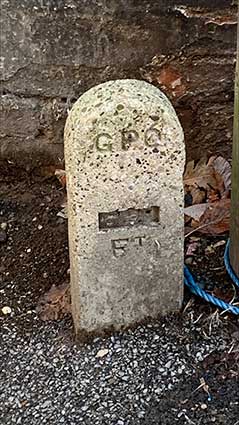 2022 image
courtesy Alan Warren
2022 image
courtesy Alan WarrenThese post were used to mark where a telephone cable runs by displaying the distance in feet using up to three interchangeable numbers. One assumes that they were intended for GPO cable engineerss, but also to warn of the presence of a cable to anyone digging in the area. The posts are at least 50 years old because they date to a time when the General Post Office was the sole provider of telephone lines, infrastructure and equipment – until this was hived off to British Telecommunications. The posts are made from reinforced concrete – because of their age, they are often crumbling away to reveal the iron reinforcing bars. At the top of the posts are the initials GPO, for the General Post Office, telecommunications branch. Underneath there is often a broad arrow or Pheon, often known as 'Crows Foot' (though not present on this example), used to mark UK Government property as the GPO was a government ministry until October 1969. Below this is a slot for the metal numbers which bolt through the marker post to show the distance from the cable. The numerals are missing in this example. Below ground level the concrete marker bells out sideways to prevent it being pulled out of the ground. [Information from http://www.ringbell.co.uk/nostalgia/AAT.htm]
'British Relay'
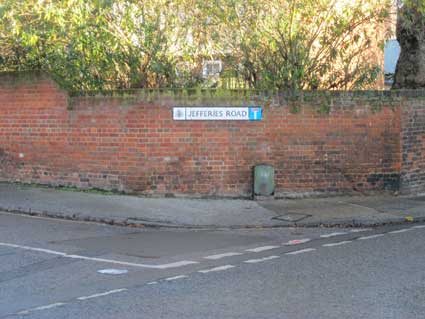 2013 images
2013 imagesJeffries Road. At first we assumed that this odd, corroded little box at the corner of St Helens Street and Jefferies Road was connected to the Ipswich Tramway system, evidence of which existed until recently in the form of power line poles in the area. A forgotten, decayed piece of street furniture, in ascending order of readability, the lettering is:
'HOOP[?]
METAL CASES
BRITISH RELAY'
However...METAL CASES
BRITISH RELAY'
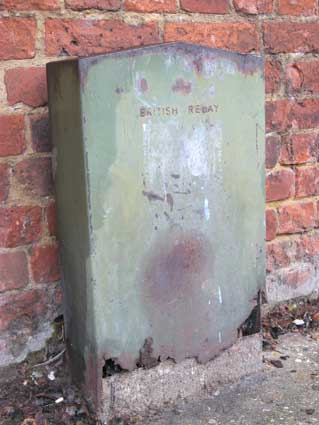
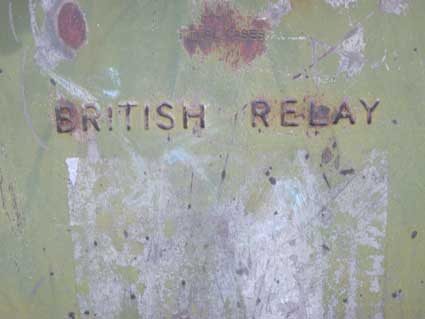
[UPDATE 13.1.2014 – Gordon Pugh writes: "Just saw on your site the pic of British Relay, could it be to do with this TV service (http://cambridge-back-chat.blogspot.co.uk/2008/03/1962-british-relay-worlds-finest.html)? Thanks to Gordon we now find that:"An option available to Cambridge [and Ipswich?] people that did give a little more choice of TV entertainment was an early form of cable or "wired" television called British Relay, which had arrived here in 1962. British Relay TV sets provided a clear, "electronically perfected" reception, the chance to view the London ITV service (which often provided a "regional variation" in programmes and news) and a built-in radio. Black British Relay cables stretched between houses and small round adaptor boxes soon became a familiar sight to Cambridge residents. British Relay was taken over by a company called Visionhire c. the late 1970s. You could rent British Relay radio and television sets from this company at least until the early 1980s (I'm not absolutely sure when the service ceased), although the TV/radio combination sets were being phased out. We were still renting a combination set in 1981." Andrew B.]
Bramford Road. Gordon adds that there are some round junction boxes which may be related to British Relay TV still to be found beneath the eaves of houses on Bramford Road and in the form of a loop of cable further down that road. Presumaby, as long as they are not in the way of repainting or repointing work, they are not worth the trouble of removal. Part of broadcasting history of which many, we assume, are unaware. There is an informative web page about British Relay (see Links).

Above: round junction boxes above 27/29 Bramford Road; loops (and triangular boxes nearby) around 239 Bramford Road.
A similar green box can be found in Fuchsia Lane.
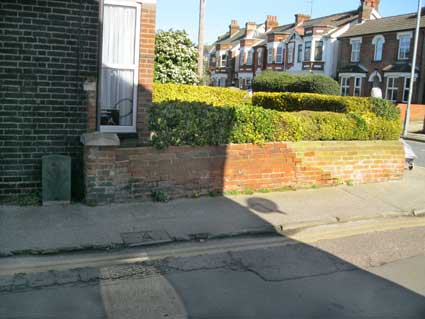
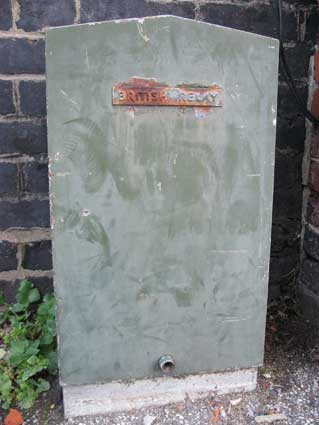 2014 images
2014 imagesNestling beside a small brick pillar close to the corner of Fuchsia Lane and Cauldwell Hall Road is a British Relay box in somewhat better condition.
Warwick Road
Another stands beside the parking restriction post at the bottom of Warwick Road (also in the photograph: 'Grove Bakery'); it has 'BRITISH RELAY' picked out in white paint.
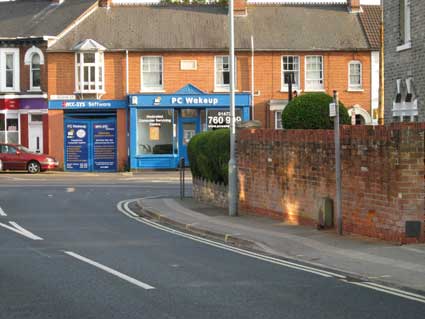
 2014
images
2014
images[UPDATE 16.11.2014: 'Just found your website which I found very informative. On the British Relay TV system, as you and correspondents have stated it was a cable radio/TV service that operated around the town from the late 1950s.
Both my parents, grandmother and several relatives in the Bramford Lane/Bramford Road/ Whitehouse estate areas had this service and, from memory, on the radio side of the dial 1-4 you could get Radios 1,2,3 and Radio Orwell. On the TV side 1=BBC1, 2=London ITV (later Channel 4), 3= ITV Anglia and 4=BBC2 – I imagine these channel numbers on the TV side were in the order the stations arrived in.
I can also tell you the service stopped around 1985/86; Visonhire, who had taken over the service, sent a letter to every customer informing a changeover to aerial televisions and, from memory, at my grandmother's house on Bramford Lane the aerial contractor arrived and erected it while the same day a Visionhire engineer arrived and installed a standard Phillips TV. I remember seeing a load of old British Relay sets in a skip at their Dales Road depot around this time
There are also several manhole covers around the town (one near the old police station on Civic Drive) in addition to the several 'green boxes' on street corners as well as the boxes on the houses you have published. My uncle who lives in my Gran's old house still has the socket in the living room! For those interested I have started a facebook page on BRW under "British Relay Wireless – remember them?". Hope this is informative. Many thanks, Darryl Tester' . Many thanks to Darryl for this information.]
Woodbridge Road
The most recent 'BRITISH RELAY' (just readable amongst the rust) junction box to be discovered is a much smaller – presumably later – affair outside no. 382 Woodbridge Road, just west of the Cauldwell Avenue juction.
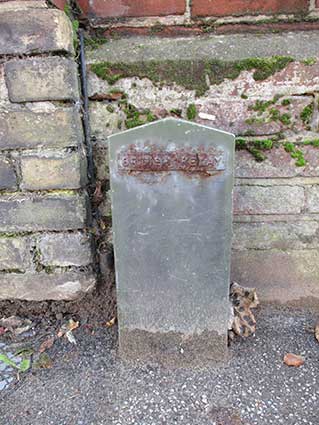
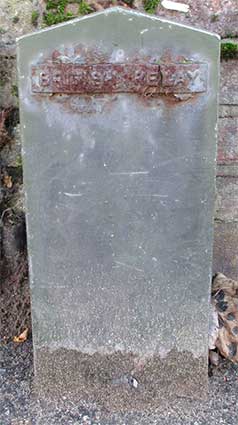 2019
images
2019
images[Update 16.5.2022: 'Hi Borin, here is another one for your British Relay page: Museum Street just outside the Police station. I didn't realise it wasn't on the site until this week. I've only walked past it every day for 18 months! Best wishes, Nigel.' Thanks for that, Nigel.The close-up shows the hard-to-read lettering.
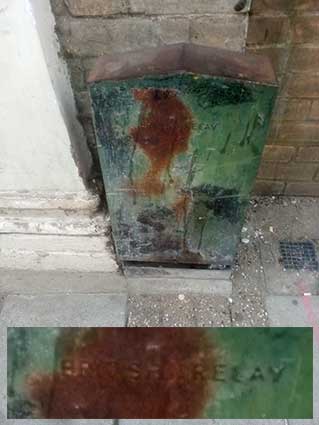 2022
image courtesy Nigel Turner
2022
image courtesy Nigel TurnerElm Street: 'CATV' cover
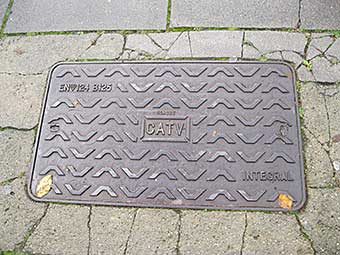 2018
image
2018
imageThe above pavement cover is in the situation mentioned by Darryl Tester, close to the site of the old Police Headquarters block on Elm Street. However, we think that this cover is much more recent:
'EN[kitemark]124 B125 ... HCA
226C ...
CATV ... INTEGRAL'
'CATV' (Cable Television) started in Ipswich, after British
Relay, in the 1990s with Cambridge Cable Ltd (founded 1988). Many
Ipswich residents will recall the myriad of 'Murphy' contractor's
vehicles and major disruption caused by the cutting-up of the pavements
and installation of green boxes and manhole pits. In 1999 Cabridge
Cable
Group were bought by NTL, later to become part of Virgin Media Ltd. (no
longer a Bransonised company).Water valve markers
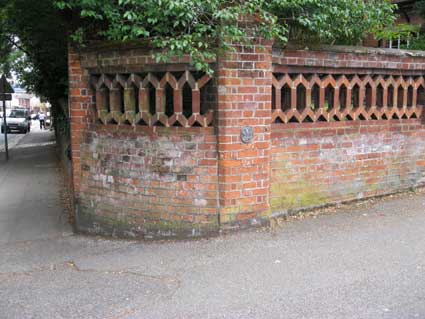
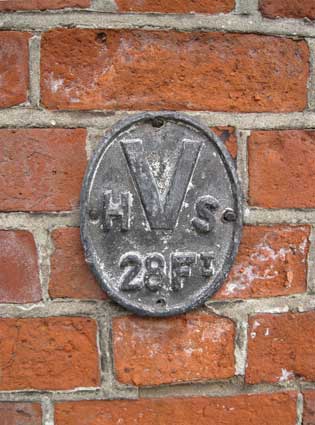
Ivry Street. These medallions are quite common on Ipswich walls. This is the corner of Henley Road and Ivry Street.
'HVS
28FT.'
We're not sure what the letters in either side signify: 'HS' is
common, but 'LH' and 'LS' used to feature on those seen in Bridge
Street. A collection of such signs can be seen at 170 Foxhall Road (see
Orianda Terrace on our Rosehill house
names page). They
indicate the position of valves on the water mains and are of late
nineteenth or twentieth century date and other examples are recorded on
our Bridge Street page, but have been
removed. Another of these can be seen up the hill from here: near the
corner of Henley Road and Park Road and yet another in Upper Orwell Street.28FT.'
Ground level (Ipswich Corporation Water Works)
Having made a page for this site based on the ground-level furniture on the Island of the Wet Dock, then the northern quays and the former Ransome's orwell Works site, we started to notice the drain, hydrant and manhole covers on Ipswich streets. This is the first example of ground-level street furniture in Ipswich to be added to the site, with more to come, we suspect.
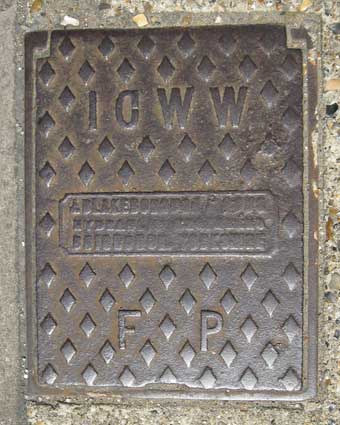 2013 images
2013 images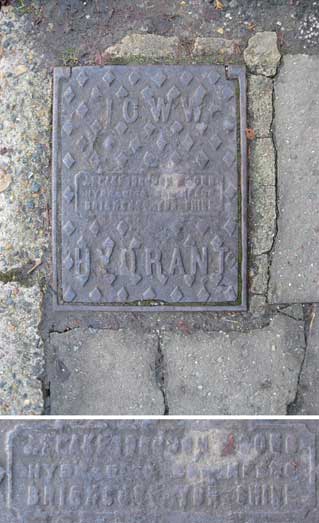
Woodbridge Road. The first cast iron cover is sited in the pavement outside 228/230 Woodbridge Road, not far from the corner with North Hill Gardens.
'ICWW
J.BLAKEBOROUGH & SONS
HYDRAULIC ENGINEERS
BRIGHOUSE YORKSHIRE
FP'
The second cover is further down on the same side of Woodbridge
Road, outside number 150 (on the corner with Palmerston Road). It shows
decidedly more wear and damage (see close-up). The lettering is the
same apart from the lower word 'Hydrant' replacing 'FP'.J.BLAKEBOROUGH & SONS
HYDRAULIC ENGINEERS
BRIGHOUSE YORKSHIRE
FP'
[UPDATE 17.8.2018: The example close to the Palmerston Road corner has suffered an outrage. Perhaps the sand/cement will weather away; the tarmac is sloppily finished. We should be grateful that the 'ICWW' cover has been retained. It could so easily have ended up in a skip.]
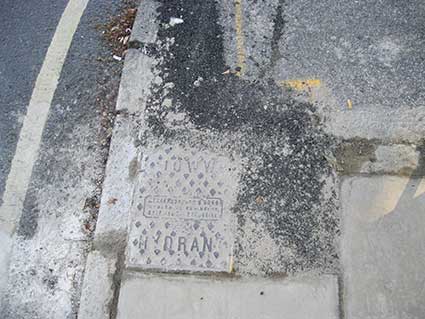 2018 image
2018 image 2014 image
2014 imageFore Street. The third example (above) shows another ICWW cover outside number 73 Fore Street, in better condition than the second, but with slightly different wording:
'ICWW
J. BLAKEBOROUGH & SONS LTD
VALVE MAKERS
BRIGHOUSE
HYDRANT'
J. BLAKEBOROUGH & SONS LTD
VALVE MAKERS
BRIGHOUSE
HYDRANT'
During recent repaving of the
area around Fore Street Pools and the Lord Nelson public house, this
cover, set at an angle to the line of paving was left in place and
concreted round. Good work. Thanks to Colin Gostling for drawing this
one to out attention.
ICWW refers to Ipswich Corporation Water Works. Ipswich Water Works Company was a private company, its directors members of the local Cobbold and Orford families. Its operations were based in Back Street off of Fore Street (later renamed Waterworks Street which now runs from Star Lane to Bond Street) in the St Clement district of the town. Just south of the Water Works the map shows Ransome's Lawn Mower Works – the building now known as The Foyer fronting the 20th century extension to Star Lane. In 1892, an act of parliament enabled the Ipswich Borough corporation to purchase the Ipswich Water Works Company, effectively making it a council department (hence 'ICWW'). In 1973 it became part of the Anglia Water Authority, one of the ten regional public authorities set up to control all aspects of water management. It was privatised in 1989. Towns can only flourish with a clean wholesome supply of drinking water and the Corporation (and others) have been supplying the town for over 800 years, initially with piped water from springs close to the Wilderness Pond in Christchurch Park, but in Victorian times from springs in the Cauldwell (cold well) Hall area, with water piped to Waterworks Street where there was also a bored water supply.
'FP' is likely to stand for 'Full Port (valve)', although we're open to correction.
This section from an 1881 map clearly shows St Clement Church ('The Sailors' Church') and to the north, Ransome's Lawn Mower Works and the Water Works and reservoir above it.
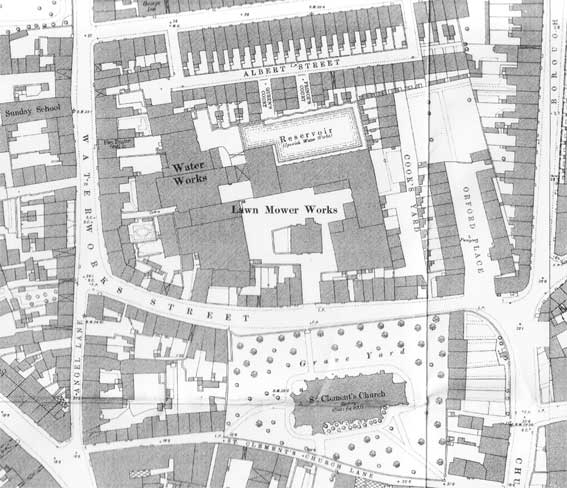 1881 map
1881 mapThe 'Sunday School' marked on the west side of Waterworks Street, on a line with Albert Street, must be the Ipswich Ragged Boys' School. We see from the map that Waterworks Street once turned a right-angle and ran along the side of St Clement Church graveyard. Reshaped and renamed 'Star Lane' under the Eastern Gyratory traffic system, this is commemorated by the unusual street nameplate on the corner with Grimwade Street:
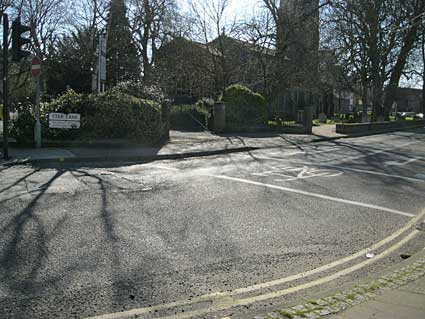
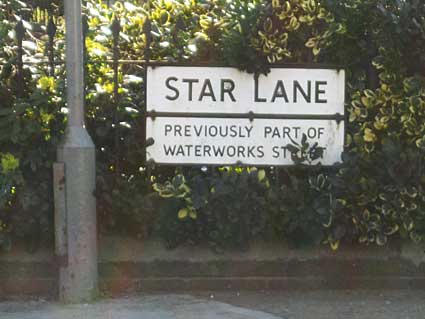 2014 images
2014 imagesManufacturer
J. Blakeborough & Sons Ltd were a large engineering company established by Joseph Blakeborough in 1866 and whose core business had been the design and manufacture of industrial water valves. Most of this work was specialised and of bespoke manufacture for the control of liquid flow. They had a large works and foundry at Brighouse in West Yorkshire that included ancillary works which in addition to their valves, also made cast-iron fire hydrant and manhole covers as well as fire fighting equipment during the 1920s and 1930s. During World War 2 (early 1940s) the company used their foundry to produce track links for British made tanks. In 1965 the company was bought by Hopkinsons Holdings of Huddersfield, also specialists in the manufacture of industrial valves. The fortunes of Blakeborough’s became more uncertain and a devastating fire in 1986 made their situation worse. In 1987 a partnership was formed with Wolstenholme Valves, a recent company set up by Chris Wolstenholme and a subsidiary of Hopkinsons Holdings at the time. The Blakeborough works at Brighouse was closed on 12th April 1989 all drawings and intellectual rights transferred to Golden Anderson Valves, Hopkinsons and Blackhall Engineering, who were all part of the Weir Group plc. Although valves ceased to be made under the Blakeborough name, these companies retained the drawings and rights to supply spares, maintain and refurbish old Blakeborough valve systems still in operation.
Bond Street. Another cast hydrant cover can be found on the pavement at the corner of Bond Street and Rope Walk. This features a local foundry:
'ICWW
C MILLS & CO
ST NICHOLAS FOUNDRY
IPSWICH
HYDRANT'
C MILLS & CO
ST NICHOLAS FOUNDRY
IPSWICH
HYDRANT'
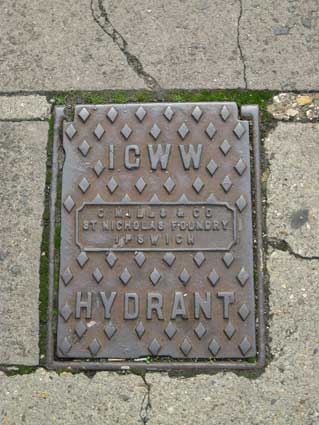
 2013
images
2013
imagesThis striking example of ground level lettering is in remarkable condition. It is very fitting that it is situated at the top of Waterworks Street. See our Dockside at ground level page for further 'C. Mills' examples and a note about the foundry.
Waterworks Cottages
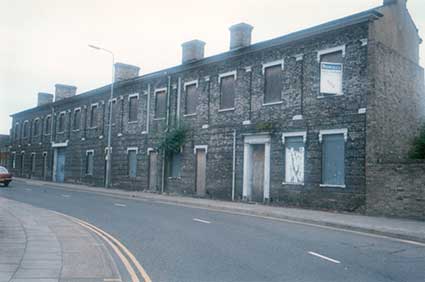 1996 image courtesy John
Norman
1996 image courtesy John
NormanAbove: a suitably moody photograph of pre-modernisation Waterworks Cottages by John Norman.
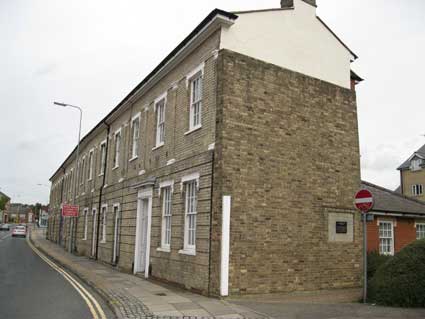

Above: Waterworks Street cottages and the commemorative plaque. See also our web page on Water in Ipswich for a photograph of the ICWW Thurleston Lane pumping station, built in 1919.

Drain vent pipes
This is a good place to include these high vents (large vertical tubes) from the drainage system. Regular visitors to Felixstowe will be familiar with these items in the town and along the promenade. However, Ipswich has them as well, although often walked past and unrecognised. Thanks to Mike Cook for recognising these and to John Norman for recording them. The first example, with casting mark, can be found on Constitution Hill on the pavement outside Woodside's extensive gardens (this large house built in 1872, is Listed Grade II* and lived in by the Paul family).
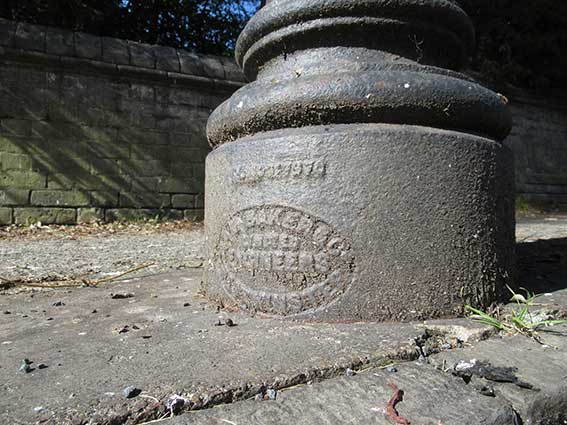
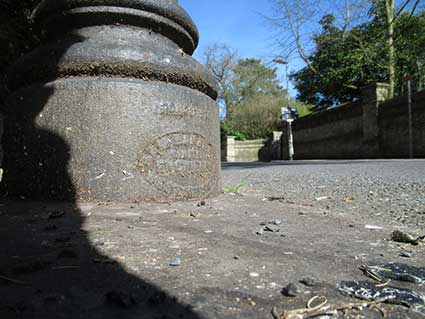
The oval casting mark which sits on the pillar's base between a serial number ans the pavement level reads:
'HAM, BAKER & CO
LIMITED
ENGINEERS
WESTMINSTER'
Established in the 1893 in the Black Country by Frederic George
Sison Ham, Ham, Baker Limited started as a general engineers and iron
and brass founders, now dedicated to the design and manufacture of
products, for the water, waste water and process sectors. They moved
their headquarters to Westminster in south-west London. Interestingly
their cast drain covers, suitably named, can still be found on the
street and the company still operates. ENGINEERS
WESTMINSTER'
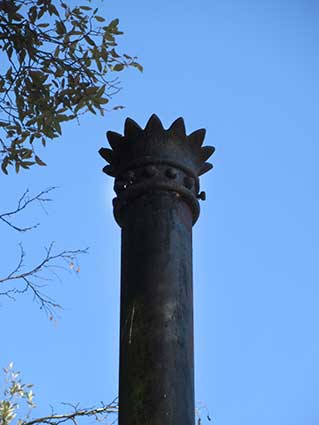 Images
courtesy
John Norman
Images
courtesy
John NormanThe third photograph from John shows the vent pipe coronet top in this location.
A more modern drain vent pipe in Alexandra Park can be found on our Water in Ipswich page.
Bollards
These items of street furniture, sometimes lettered, can be found in a range of shapes and sizes. One of the more remarkable is the bell bollard descibed on our King Street page. A variation of this is sent in by Sandy Phillips which she spotted (April 2023) outside the Lidl store on Handford Road.
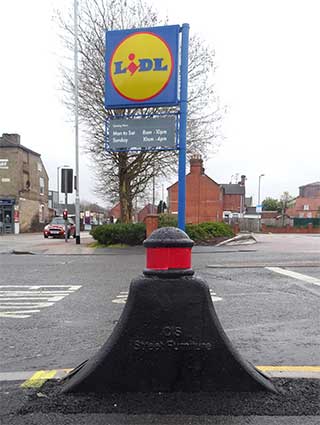 2023
image courtesy Sandy Phillips
2023
image courtesy Sandy PhillipsThis variation on the bell bollard replaces the circular section with a rectangular base. The upper finial appears to have red duct tape around it. It bears the cast lettering 'CIS Street Furniture', a Guildford-based manufacturer.
- Maritime bollards can be seen on our Wet Dock ground level page.
- Our St Clement Church page has two types of bollard, one of which is lettered and made by the Ipswich firm Compair Reavell.
- A cannon bollard once sited in Wherry Lane can be seen on our Isaac Lord page.
- Steel bollards which are frequently hit by heavy vehicles can be seen at the top of Argyle Street: see our Atlas House page.
Ground level
Woodbridge Road East
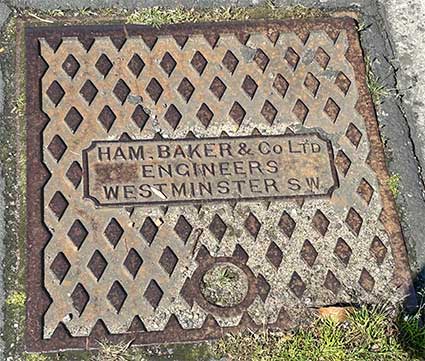 2024 image
2024 image'HAM BAKER & CO LTD
ENGINEERS
WESTMINSTER SW'
Sited on the south pavement of Woodbridge Road East,
near to the Two Rivers medical centre, this cast iron cover echoes the
manufacturer of the ventilation shaft on Consitution Hill (shown
above). Only a short distance away from the Ham, Baker cover is this
large example with a constellation of relief diamonds (theoretically to
prevent slippage as one walks over it) surrounding the rather worn
lettering in its rectangular frame:ENGINEERS
WESTMINSTER SW'
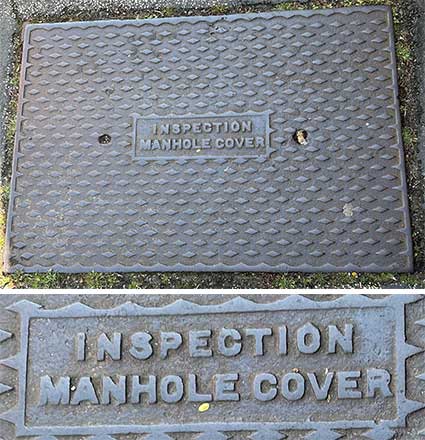 2024 image
2024 image'INSPECTION
MANHOLE COVER'
MANHOLE COVER'
Ipswich Corporation Electricity Department
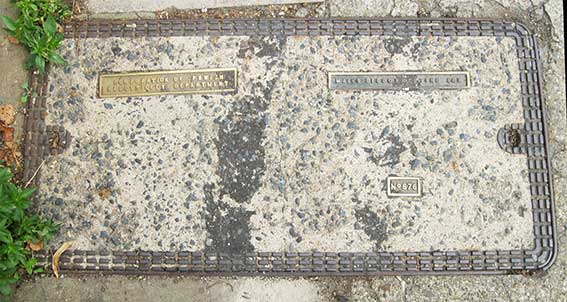 2017
images
2017
imagesThis example was spotted close to Farringdon Villas, 193 Woodbridge Road set into the pavement. The lettered panels appear to be made of brass.
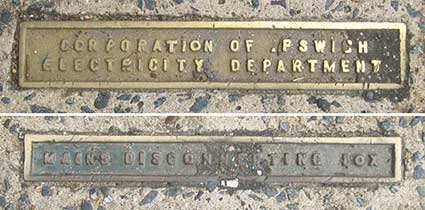
'CORPORATION OF IPSWICH
ELECTRICITY DEPARTMENT'
'MAINS DISCONNECTING BOX'
'NO. 676'
Once again, as in the Water Works examples above, we see a cast
metal reference to Ipswich Corporation and its intimate involvement
with
one of those services on which people depend. We have found
several references to the Corporation's power station:-ELECTRICITY DEPARTMENT'
'MAINS DISCONNECTING BOX'
'NO. 676'
At the turn of the 19th/20th century… 'Battery-electric traction began in Ipswich when Frank Ayton came to town. The contract to oversee the construction of Ipswich’s electric tramway had been won by Kennedy and Jenkin of Westminster: Frank Ayton was their assistant engineer and spent five years in their employ. He was then appointed chief engineer and manager of the Ipswich Corporation lighting and tramway undertakings, running both the power station in Constantine Road and the trams operating from the depot in the sheds adjacent (Ipswich Buses still occupy these buildings).
At this time the generation of electricity was a Corporation undertaking, the power station having been built primarily to supply the current for the trams. Most homes were still lit by gas and warmed using coal fires.
Frank spent some 20 years with the Municipal Borough of Ipswich before moving, in 1921, to Ransomes, Sims and Jefferies Ltd., at their Orwell Works, as their joint managing and works director. Needless to say, his prime function at Ransomes was to develop electric vehicle production.' (John Norman's Ipswich Icons, 19.7.2015, East Anglian Daily Times.)
'After the construction of Lloyds Avenue, The Ipswich Corporation opened new offices and showrooms that were named Electric House. This caused fears amongst electrical contractors in Ipswich that the showrooms would take business away from them.
At the time, Hampton E. Blackiston was Manager and Chief Engineer of Ipswich Corporation Electricity Department and he conceived the “idea" of inviting the Contractors to meet him in order to discuss matters affecting the Electrical Industry within the borough. This meeting took place at Electric House on May 12th 1933 and one resolution which was passed unanimously was that a local organisation, to be called the "Ipswich and District Electrical Association", should be formed.
The Association was formed at a meeting held at Electric House on Monday May 22nd, 1933. The object of the Association was " To assist to the utmost, the use of Electricity in the Borough of Ipswich and District"- the district meaning the area surrounding Ipswich supplied with Electricity by Ipswich Corporation.
Membership of the Association was divided into two categories:
(1) Manufacturers and Factors (Wholesalers)
(2) Electrical Contractors
Mr. Hampton E. Blackiston was appointed Chairman. The other officers were: Secretary, Mr H. Wintle and Treasurer, Mr F. Crush. An Exectutive Commitee of seven members was formed, three from Manufacturers and Factors and four from Electrical Contractors. A sub-Commitee of Contractors was also formed to deal exclusively with contracting matters. The Chairman, Secretary and Treasurer were ex-officio members of both committees.
The ensuing months were ones of cautious progress. The matters discussed were, amongst other things, the cost of electricity, fair trading and joint advertising in the local press. Advertisements appeared in the Evening Star in September and the East Anglian Daily Times in December.
On 15th March 1934 the first Annual dinner was held at the Crown and Anchor Hotel in Westgate Street. The principal guests at the Dinner were Sir John Ganzoni, MP for Ipswich, the Mayor of Ipswich and the Chairman of Ipswich Corporation Electricity Department. The first year of the Association concluded with the Annual General Meeting at which Mr H.E. Blackiston was unanimously re-elected Chairman.
The second year saw the formation of a set of Rules of the Association and the widening of the membership to include representatives of other Supply Authorities that took electricity from the Corporation's power station. It also saw a new office of President created at the second AGM, a post unanimously filled by the outgoing Chairman Mr Blackiston.
The Association continued to flourish during the remaining years of the thirties with the production of a booklet entitled Electricity Service in East Anglia in 1936 and an exhibition to promote electrical goods and services in 1937.
At the 1939 Annual Dinner the association bade farewell to it's founder and President, Mr Blackiston, the occasion being marked with a suitable presentation.
The Association continued to expand and develop over the coming years, however, regular meetings were reduced during the War years of 1939-45. After the War the Association prospered and in 1953 an official badge-of-office was introduced for the Chairman to wear at all official functions. The badge, depicting the new Ipswich Cliff Quay coal-fired power station (now demolished), is still in use today and the centre-piece of the badge forms the Associations logo and is represented on our Home page.' (Ipswich and District Electrical Association [I.D.E.A. http://idea.onesuffolk.net]. The association was formed in 1933 by those working in the electrical industry within the Ipswich Corporation electricity supply area. Ipswich, in those days, had its own Electrical Generating Station.)
Ipswich Gas Company
[UPDATE 24.7.2019: 'Hi Borin, I happened upon this cover set into the edge of the footpath outside 24 Waterford Road on the Whitehouse estate. Waterford Road has short cul-de-sacs running off it on one side and this is at the end of one of these legs. I am sorry I didn’t add anything to show the scale of it but it was probably only 4-5 inches across.
I briefly checked your site and couldn’t find anything similar. I never knew that there was an Ipswich Gas Company. As it is not something that I have ever noticed before, I thought I would share it with you. Best regards, Simon Bole. Many thanks to Simon for this example, a new one on us. Ipswich certainly had a large gasworks on the eastern quays, more or less where Patteson Road/Maude Street northwards is today. They even had their own quay cut into the site to receive coal by ship. There are photographs of ‘Jumbo’ the German-built, timber-clad gasometer, as well as smaller, more conventional gasometers plus an 1867 map showing the 'Gas Works & Depot'on our Ransomes Orwell Works site page. See also an image relating to the Ipswich Gas Light Company on our Island site page.]]
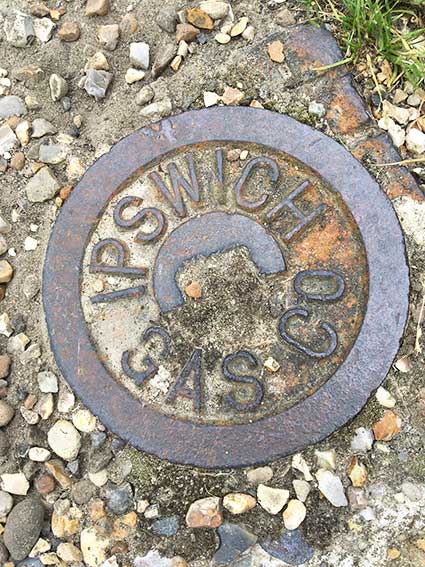 Photograph
courtesy Simon Bole
Photograph
courtesy Simon Bole'IPSWICH GAS CO'
The circular cover is part of a larger rectangular casting,
visible at upper right. Cement and chippings obscure the remainder. The
'G' of 'GAS' is broken, but the fitting of the capitals into a tight
circle is a rather admirable design. John Norman writes: 'One of
Ipswich's little known claims to fame is that it had gas street
lighting as early as 1821, the gas being the by-product of coke
production for Robert Ransome's foundry. However, like all gas
companies, the Ipswich Gas Light Company was nationalised by Attlee's
Labour Government in 1948, and then sold off (remember "If you see Sid,
tell him" campaign) in 1986.'H.Warner & Son Ltd.
In February 2023, Sandy Phillips found these two examples in the Portman Road car park – an extensive piece of tarmac – towards the back exit. Our thanks to her for sending the images.
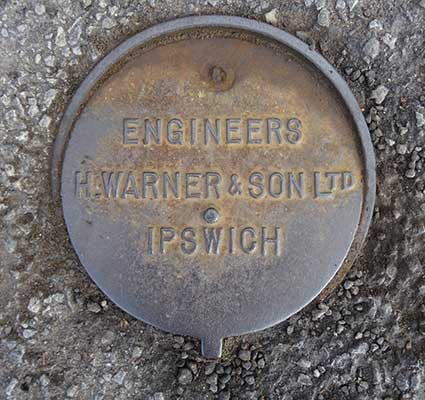
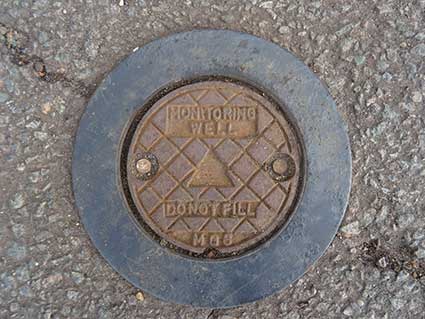 2023 images courtesy Sandy Phillips
2023 images courtesy Sandy PhillipsThe first example reads:
'ENGINEERS
H.WARNER & SON LTD.
IPSWICH'
Another engineering company in Ipswich?... However, it
did ring a vague bell. When looking at our King
Street/Lion Street page, an advertisement from 1936 for the company
was found. Sandy's photograph prompted another internet search and we
found not only the nature of the business, but also (perhaps
surprisingly) the address in Lion Street, a Listed building, from which
they operated. See that page for more information and images. The
second example is probably more modern:H.WARNER & SON LTD.
IPSWICH'
'MONITORING
WELL
DO NOT FILL
MG8'
This enigmatic cast cover reminds us of the 'Drain
Rodding Point' shown further down this page. Perhaps some
drainage/water management engineer will let us know the meaning.WELL
DO NOT FILL
MG8'
More ground level
596 Foxhall Road. "This is an early 1920s domestic drain cover. What is interesting is that there were only 5 houses built by my grandfather so it must have been a local supplier who was able to customise the covers.
It is in the middle of the drive near the front gates. We had two of these – one at the house end as well but it was broken when a lorry backed onto it in the 1960s. I think it is the only one left as a check of the other houses from the road to the corner of Chilton Road shows they have all modernised the drives and replaced them.
My grandad was Harry Buss. - Jen Greatrex" Many thanks to Jen for this intriguing bit of advertising matter; the uneven lettering suggests that this is a custom-made cover by a local foundry.
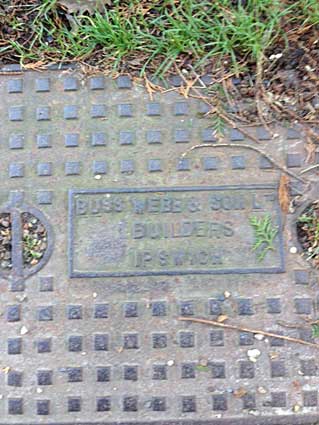 Photograph
courtesy Jen Greatrex 2014
Photograph
courtesy Jen Greatrex 2014'BUSS WEBB & SON LTD
BUILDERS
IPSWICH'
Chilton RoadBUILDERS
IPSWICH'
Similarly, round the corner in Chilton Road where there are four of these, all from the same builder, in close proximity. These are on 1930s drives.
'LFJ PACKARD
BUILDER
FOXHALL ROAD
IPSWICH'
BUILDER
FOXHALL ROAD
IPSWICH'

 Photographs
courtesy Jen Greatrex 2014
Photographs
courtesy Jen Greatrex 2014Another drain cover lettered by a local builder turned up in Felixstowe Road; see our Named buildings examples page under 'Grindlewald'.
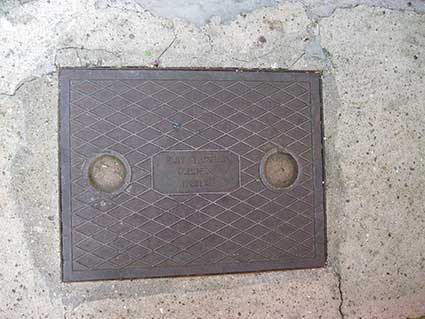
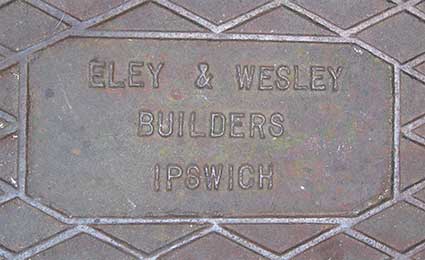 2020
images
2020
imagesAbove: a household main drain cover in cast iron; these houses in Belle Vue Road were built in the late 19th century:
'ELEY & WESLEY
BUILDERS
IPSWICH'
In 2020 this building firms continues in business. One of the
partners had been born in 1916, so it would appear that this drain
cover is a later replacement.BUILDERS
IPSWICH'
High Street. Close to the corner of High Street and Crown Street on the High Street pavement is an example of a curious modern drain cover which has been spotted elsewhere in the town. An oval cover set into a concrete surround: it's quite small and easily missed.
 2014
image
2014
image'SUPER SLEVE
PATENT NO. I421734
DRAIN RODDING POINT'
192 Woodbridge Road
has
a cast Fire Hydrant outside on
the pavement (and it came all the way from Exeter: couldn't they find
any iron founders nearby?):PATENT NO. I421734
DRAIN RODDING POINT'
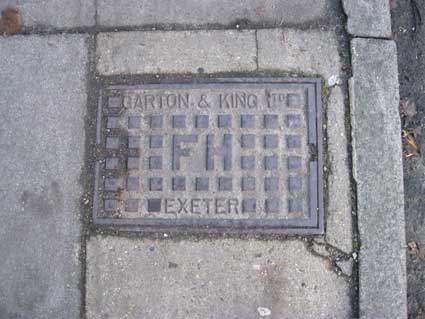
'GARTON & KING LTD.
FH
EXETER'
Not far from here is a very worn cast cover for a cross-pavement
drain bearing a very worn: 'C. MILLS & CO. IPSWICH'.
This foundry name can be found on several covers on The Island at the Wet Dock and in
Derby Road (below).FH
EXETER'
[UPDATE
21.2.2014: 'Hi there - saw your website on Iron and Street Furniture
etc in Ipswich – Glad to see Ipswich was a customer of Garton &
King – have you seen the website
on the History of the Company – goes way way back to 1661! [see Links] Regards, Richard Holladay' Many thanks to
Richard for these two examples of the company's output; the website has
a fascinating story of the company. Captions as
supplied by Richard.]
 Large rectangular on NDWB installation
Merrifield X on B3254
Large rectangular on NDWB installation
Merrifield X on B3254
 EDWB - everything facing the right way sq
18
EDWB - everything facing the right way sq
18
[We assume that 'EDWB' is Exeter District Water Board.]
 Large rectangular on NDWB installation
Merrifield X on B3254
Large rectangular on NDWB installation
Merrifield X on B3254 EDWB - everything facing the right way sq
18
EDWB - everything facing the right way sq
18[We assume that 'EDWB' is Exeter District Water Board.]
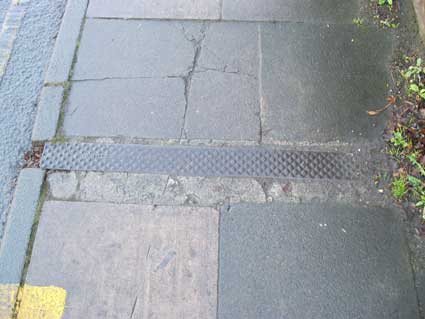
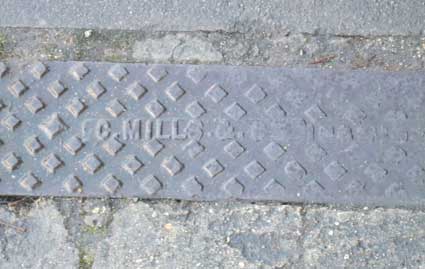
It really is extraordinary how many elements are cut through our road and pavement surfaces. During a recent stroll in Crabbe Street, we lost count of the number of small circular (mainly plastic) covers in the pavement. Water, gas, electricity, traffic lights, telephones, cable services and some we can only guess at can be spotted at various locations, particularly close to residential buildings.

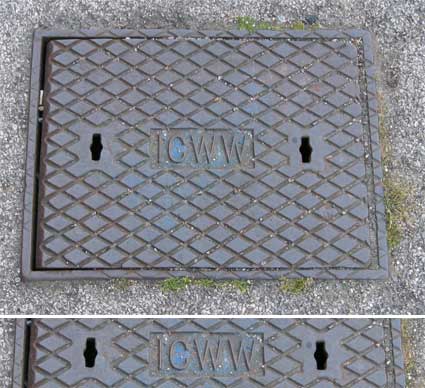
Felixstowe Road area. A stroll around the Rosehill area reveals the wide variety of pavement and road level lettering on inspection and manhole covers. The familiar:
'POST-OFFICE-TELEPHONES'
in Felixstowe Road displays the familar 'surface of the moon'
damaged concrete centre. 'ICWW'
appears in the centre of a rather new-looking cover (see above
for information about Ipswich Corporation Water Works).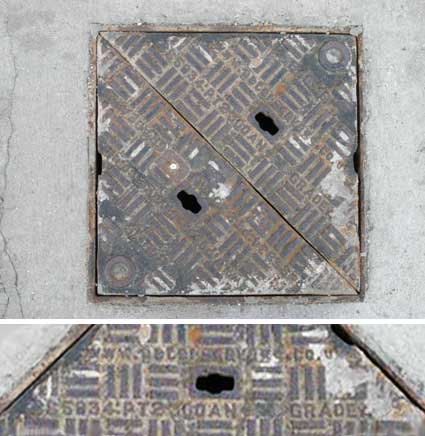
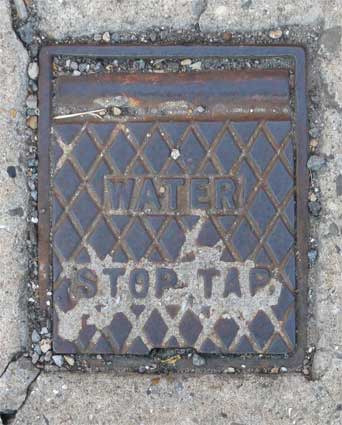
Just to give the lie to first impressions, the above left slightly battered, rusting cover bears the inscription on each side:
'B4D-16
www.peter-savage.co.uk
BS5834:PT2 300AN GRADEA'
www.peter-savage.co.uk
BS5834:PT2 300AN GRADEA'
So, a very modern cover with its
World Wide Web address. Much more workaday and to the point is:
'WATER
STOP TAP'
STOP TAP'
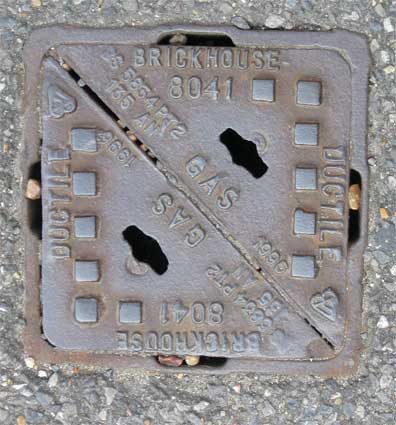
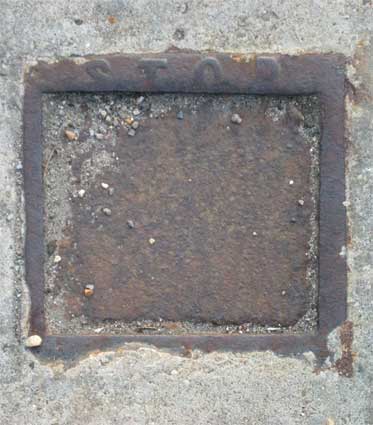
In Derby Road is another cover with diagonal split reading:
'BRICKHOUSE
8041
BS 5854 PT2
135 AN
GAS
1990
DUCTILE [KITEMARK]'
8041
BS 5854 PT2
135 AN
GAS
1990
DUCTILE [KITEMARK]'
The older cover above right used
to read:
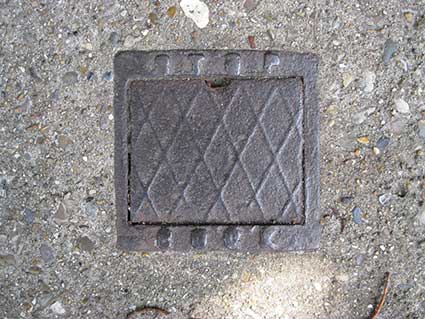
 2018
image
2018
image
It was not until 2018 that we noticed a fully-visible 'STOP COCK' in the pavement of Henley Road, close to the upper gate of the Arboretum.
'STOP
COCK'
but the latter word has been covered by a recent concrete
surround.COCK'

 2018
image
2018
imageIt was not until 2018 that we noticed a fully-visible 'STOP COCK' in the pavement of Henley Road, close to the upper gate of the Arboretum.
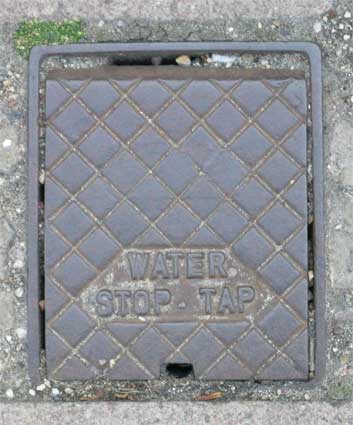
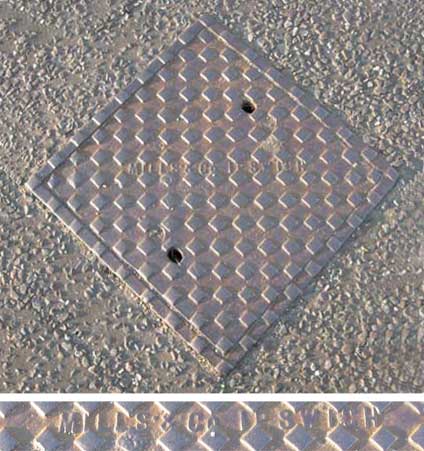
A more modern take on the 'WATER STOP TAP' cover. The road manhole cover above right features:
'MILLS & CO
IPSWICH'
which is a foundry name also seen on the manhole covers on 'the island' at the Wet Dock and on
Woodbridge Road (above).Handford Road drain cover
 2024 image
courtesy Sandy Phillips
2024 image
courtesy Sandy Phillips'I spotted this on my walk this evening, not sure if you have this in the website collection. It is outside 'Vets 4 Pets', [98] Handford Road. Sandy Phillips.' (14.4.2024) The cast cover seems to have had a wall built over the right-hand portion.
'GIRLINGS LTD.
ENGINEERS
MALDON'
ENGINEERS
MALDON'
Post Office Telegraphs

'POST-OFFICE
TELEGRAPHS'
These two covers stand on the south-western pavement crossing at
the Derby Road / Cauldwell Hall Road / Foxhall Road junction. We're
back to the familiar lumpy metal surrounds and grainy concrete centres.
This time the lettering harks back to the days of wireless telegraphy.
The General Post Office (GPO) was officially established in England in
1660 by Charles II and it eventually grew to combine the functions of
state postal system and telecommunications carrier. In 1980 the
telecommunications and postal sides were split prior to the splitting
off of British Telecommunications into a totally separate publicly
owned corporation the following year as a result of the British
Telecommunications Act, 1981. Yes, 'The BT Research Station', a
national centre built on the former airfield at Martlesham Heath was
for many years known as 'The Post Office Research Station'. Nowadays,
people call it just 'BT' which removes a great deal of the resonance of
the name. When new forms of communication came into existence in the
19th and early 20th centuries the GPO claimed monopoly rights on the
basis that like the postal service they involved delivery from a sender
and to a receiver. The theory was used to expand state control of the
mail service into every form of electronic communication possible on
the basis that every sender used some form of distribution service.
These distribution services were considered in law as forms of
electronic post offices. This applied to telegraph and telephone
switching stations. In the mid 19th century several private telegraph
companies were established in the UK. The Telegraph Act 1868 granted
the Postmaster-General the right to acquire inland telegraph companies
in the United Kingdom and the Telegraph Act 1869 conferred on the
Postmaster-General a monopoly in telegraphic communication in the UK.
The responsibility for the ‘electric telegraphs’ was officially
transferred to the GPO on Friday, 4 February 1870. Overseas telegraphs
did not fall within the monopoly. The private telegraph companies that
already existed were bought out. The new combined telegraph service had
1,058 telegraph offices in towns and cities and 1,874 offices at
railway stations. 6,830,812 telegrams were transmitted in 1869
producing revenue of £550,000.TELEGRAPHS'
Definitions
Telegraph.
'Tele': from the Greek afar / ata distance, 'graphein': to
write. An apparatus, system, or process for transmitting
messages or signals to a distant place, especially by means of an
electric device consisting essentially of a sending instrument and a
distant receiving instrument connected by a conducting wire or other
communications channel.
Telephone. The name was coined in 1835, "apparatus for signaling by musical notes" (devised by Sudré in 1828), from French téléphone (c.1830), from the Greek télé- "afar" + phone "voice/sound". Also used of other apparatus in the early 19th century, including "instrument similar to a foghorn for signalling from ship to ship" (1844). The electrical communication tool was first described in modern form by P.Reis (1861); developed by Alexander Graham Bell, and so called by him from 1876.
Telephone. The name was coined in 1835, "apparatus for signaling by musical notes" (devised by Sudré in 1828), from French téléphone (c.1830), from the Greek télé- "afar" + phone "voice/sound". Also used of other apparatus in the early 19th century, including "instrument similar to a foghorn for signalling from ship to ship" (1844). The electrical communication tool was first described in modern form by P.Reis (1861); developed by Alexander Graham Bell, and so called by him from 1876.
Crown Street (outside The Cricketers)
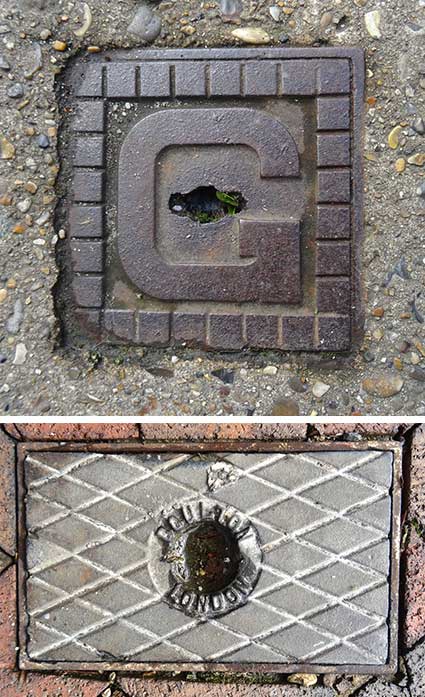 2023 image
courtesy Sandy Phillips
2023 image
courtesy Sandy PhillipsAbove: 'On Crown Street opposite the Cricketers garden is the large 'G' point. At the base of the down pipe on the corner of the Cricketers is the 'Doulton London' cover. Sandy Phillips'. Thanks to Sandy for adding to her contributions of images of drain and other ground-level castings (see also our Cocksedge page). What does the 'G' stand for? The name Doulton is most associated with John Doulton (1793-1873) and Royal Doulton ceramics, but we don't think this drain cover is connected.
For more ground level lettering see 'the island' on the Wet Dock; a page of the ground level dockside furniture to be seen on the northern quays. Further round the dock is Ransome's Orwell Works site with remnants at ground level. An interesting cast, glazed manhole cover can be found in Museum Street.
Foxhall Road, petrol pump
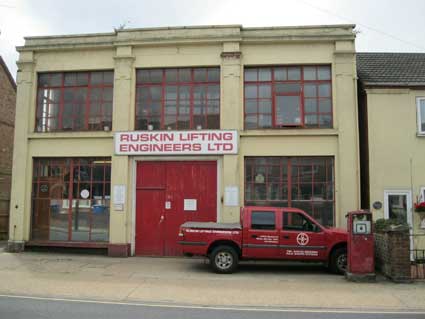 2013 images
2013 imagesThe elderly petrol pump standing in front of Ruskin Lifting Engineers Ltd at 84 - 86 Foxhall Road just about counts as street furniture, even though it's probably technically on private land. While in 2013 'Ruskin Lifting Engineers Ltd' (standing opposite the jaws of Ruskin Road) is still a going concern, one doubts whether the pump still functions...
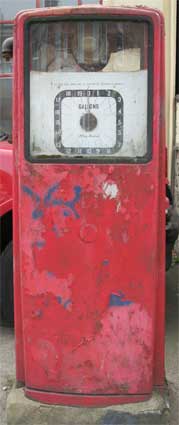
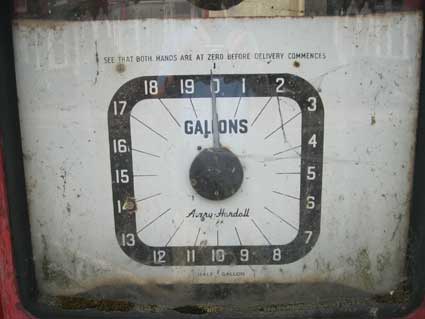
The dial bears the numerals 0 to 19 then 'GALLONS' (with a small 'HALF GALLON' beneath the numeral 10). This suggests a 'clock face' display with two rotating hands: the smaller making a complete sweep for a gallon and the larger registering the number of gallons. The manufacturer's name in a cursive script: 'Avery-Hardoll' sits below the centre. At the top in capitals:
'SEE THAT BOTH HANDS ARE AT
ZERO BEFORE DELIVERY COMMENCES'
Related pages:
A classic piece of street furniture now fast disappearing, see the K6 telephone kiosk near Stoke Bridge.
Our St Helens Street page for examples of street furniture which relate to the old Ipswich tramways.
Garden railings and gates.
See also our Lettered castings index page.
House name plaque examples: Alston Road; Bramford Road; Cauldwell Hall Road; Cavendish Street; Marlborough Road; Rosehill area;
Ipswich & Suffolk Freehold Land Society (F.L.S.); California
Street index; Streets named after slavery abolitionists;
Dated buildings list; Dated buildings examples;
Named buildings list; Named (& sometimes dated) buildings examples.
Street nameplate examples; Examples of Street nameplates (Parliament Road etc.);
Brickyards; Ropewalks
©2004 Copyright throughout the Ipswich Historic Lettering site: Borin Van Loon
No reproduction of text or images without express written permission